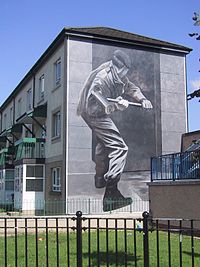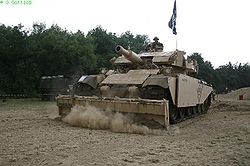- Operation Motorman
-
For the unrelated ICO investigation, see Operation Motorman (ICO investigation).
Operation Motorman Part of The Troubles and Operation Banner 
A mural painted by the Bogside Artists depicting an event that occurred during Operation Motorman.Location Belfast, Derry, Newry, Armagh, Lurgan, Coalisland Objective Retake republican-controlled areas Date 31 July 1972
0400 (BST)Executed by  British Army (22,000)
British Army (22,000)
 Ulster Defence Regiment (5,300)
Ulster Defence Regiment (5,300)Outcome Operation succeeds Casualties Civilians: 1 killed, 2 wounded
Republicans: 1 killedOperation Motorman was a large operation carried out by the British Army in Northern Ireland during the Troubles. The operation took place in the early hours of 31 July 1972 with the aim of retaking the "no-go areas" (areas controlled by Irish republican paramilitaries) that had been established in Belfast, Derry and other large towns.
Contents
Background
The Northern Ireland riots of August 1969 marked the beginning of the conflict known as "The Troubles". As a result of the riots, Northern Ireland's two main cities—Belfast and Derry—had become more segregated than before. Many neighbourhoods became either purely Irish nationalist and republican or purely unionist and loyalist. In some places, residents and paramilitaries built barricades to seal-off and protect their neighbourhoods from incursions by "the other side", by the security forces, or both. These became known as "no-go areas".
By the end of 1971, 29 barricades were in place to block access to what was known as Free Derry; 16 of them impassable even to the British Army's one-ton armoured vehicles.[1] Many of the nationalist/republican "no-go areas" were controlled by one of the two factions of the Irish Republican Army—the Provisional IRA and Official IRA. On 29 May 1972, the Official IRA called a ceasefire[2] and vowed that it would only launch attacks in self-defence.
On 21 July 1972, in the space of 75 minutes, the Provisional IRA detonated 22 bombs in Belfast. Nine people (including two soldiers and a loyalist paramilitary) were killed and 130 were injured. This attack prompted the British Government to implement Operation Motorman, just ten days later.[2]
Preparations
Operation Motorman would be the biggest British military operation since the Suez Crisis of 1956, and the biggest in Ireland since the Irish War of Independence.[2] In the days before 31 July, about 4,000 extra troops were brought into Northern Ireland.[2] Involved were almost 22,000 soldiers[2]—including 27 infantry and two armoured battalions—aided by 5,300 soldiers from the local Ulster Defence Regiment (UDR).[3] Several Centurion AVRE demolition vehicles, derived from the Centurion tank, were used. These were the only heavy tanks to be deployed operationally by the British Army in Northern Ireland during the Troubles. The tanks had been transported to Northern Ireland on board the amphibious landing ship HMS Fearless, and were operated with their main guns pointed to the rear, covered with tarpaulins.[4]
This quick military build-up alerted the Provisional IRA and Official IRA that a major operation was being planned.[5]
The operation
The operation began at about 4:00am on 31 July and lasted for a few hours. In "no-go areas" such as Free Derry, sirens were sounded by residents to alert others of the incursion.[6] The British Army used bulldozers and the Centurion AVREs to smash through and dismantle the barricades, before flooding the "no-go areas" with troops in armoured vehicles.[2][5] The Provisional IRA and Official IRA were not equipped to battle such a large force and did not attempt to hold their ground.[5] Small scale operations were carried out in other places like Lurgan, Armagh, Coalisland and Newry.[7] By the end of the day, Derry and Belfast had been cleared of "no-go areas", but the Army remained cautious when operating in staunchly republican districts.
Casualties
During the operation, the British Army shot four people in Derry, killing a civilian and an unarmed IRA member.
- Daniel Hegarty, a 15-year-old Catholic civilian,[8] was shot along with his two cousins as they walked along Creggan Heights in Derry.[9] The boys had gone out to see the tanks and watch the operation unfold.[9] The shots were fired from close range by soldiers who had hidden themselves behind a garden fence.[9] Daniel was killed outright. In June 2007, 35 years later, the Ministry of Defence (MoD) released a document that described Daniel as a "terrorist" and claimed that he was armed. Two months later, the MoD withdrew and apologised for the document, accepting that "Daniel was innocent and that the reference to him as a terrorist was inaccurate".[10]
- Seamus Bradley, a 19-year-old Provisional IRA member,[8] was shot as he climbed a tree in Bishop's Field, Derry.[11] He was shot in the leg from long range by soldiers who had hidden themselves behind a hedgerow.[11] The soldier who shot him claimed that he had been armed at the time. However, when a group of soldiers arrived to arrest him, no weapon was found.[11] Seamus was then taken away in a Saracen APC and bled to death while in the custody of British soldiers.[5]
In Belfast some arrests were made but no armed resistance was met.
Aftermath
A few hours after the conclusion of Operation Motorman, the Claudy bombing occurred. Nine civilians were killed when three car bombs exploded on the Main Street of Claudy village, County Londonderry. Five of the victims were Catholic and four were Protestant.[12]
See also
- Timeline of Ulster Defence Regiment operations
References
- ^ Taylor, Peter (2001). Brits: The War Against the IRA. Bloomsbury Publishing. p. 83. ISBN 0-7475-5806-X.
- ^ a b c d e f CAIN: Chronology of the Conflict - 1972
- ^ An Analysis of Military Operations in Northern Ireland, prepared under the direction of the Chief of the General Staff. Retrieved 2007-09-02.
- ^ Osprey Publishing: Centurion Universal Tank 1943–2003 ISBN 1-84176-387-X
- ^ a b c d Museum of Free Derry: Operation Motorman
- ^ The Pat Finucane Centre: Operation Motorman
- ^ Operation Motorman from Britain small wars
- ^ a b CAIN - Sutton Index of Deaths - 31 July 1972
- ^ a b c The Pat Finucane Centre: Daniel Hegarty
- ^ MoD apology to shot teen's family BBC News Online, 31 August 2007. Retrieved 2007-09-02.
- ^ a b c The Pat Finucane Centre: Seamus Bradley
- ^ Cowan, Rosie (2002-09-21). "Does this letter prove a priest was behind IRA bombing?". The Guardian (London). http://www.guardian.co.uk/uk/2002/sep/21/northernireland.ireland. Retrieved 2010-05-20.
External links
- The Pat Finucane center
- Operation Motorman from Britain small wars
- CAIN project
The Troubles History of Ireland · History of Northern Ireland · History of the United Kingdom · Irish nationalism · Irish republicanism · Irish unionism · Ulster loyalism Participants in the Troubles Chronology Political Parties Republican
paramilitariesSecurity forces of the United Kingdom
Loyalist
paramilitaries• Ulster Defence Association
• Ulster Volunteer Force
• Loyalist Volunteer Force
• Red Hand Commandos
• Young Citizen Volunteers
• Ulster Young Militants
• Ulster Resistance
• UVF Mid-Ulster Brigade
Linked to
• Some RUC and British Army members• Northern Ireland Civil Rights Association formed (1967)
• Battle of the Bogside (1969)
• Riots across Northern Ireland (1969)
• Beginning of Operation Banner (1969)
• Social Democratic and Labour Party formed (1970)
• Internment without trial begins with Operation Demetrius (1971)
• Bloody Sunday by British Army (1972)
• Northern Ireland government dissolved. Direct rule from London begins (1972)
• Bloody Friday by Provisional IRA (1972)
• Power sharing Northern Ireland Assembly set up with SDLP and Ulster Unionist Party in power (1973)
• Mountjoy Prison helicopter escape. Three Provisional IRA prisoners escape from Mountjoy Prison by helicopter (1973)
• Ulster Workers' Council strike causes power-sharing Northern Ireland Assembly to end (1974)
• Dublin and Monaghan bombings by UVF with alleged British Army assistance (1974)
• Kingsmill massacre by South Armagh Republican Action Force (1976)
• Warrenpoint Ambush by Provisional IRA (1979)
• 1981 Irish hunger strike by Provisional IRA and INLA members (1981)
• Hunger striker Bobby Sands elected MP. Marks turning point as Sinn Féin begins to move towards electoral politics (1981)
• Maze Prison escape. 38 Provisional IRA prisoners escape from H-Block 7 of HM Prison Maze (1983)
• Brighton hotel bombing by Provisional IRA (1984)
• Anglo-Irish Agreement between British and Irish governments (1985)
• Remembrance Day bombing by Provisional IRA (1987)
• Peace Process begins (1988)
• Operation Flavius, Milltown Cemetery attack and Corporals killings (1988)
• Bishopsgate bombing (1993)
• Downing Street Declaration (1993)
• First Provisional IRA ceasefire (1994)
• Loyalist ceasefire (1994)
• Docklands bombing (1996)
• 1996 Manchester bombing (1996)
• Second Provisional IRA ceasefire (1997)
• Good Friday Agreement (1998) signals the end of the Troubles
• Assembly elections held, with SDLP and UUP winning most seats (1998)
• Omagh bombing by dissident Real IRA (1998)• Unionist parties:
• Democratic Unionist Party
• Northern Ireland Unionist Party
• Ulster Unionist Party
• Progressive Unionist Party
• Conservative Party
• UK Unionist Party
• Traditional Unionist Voice
• Nationalist parties:
• Democratic Left
• Fianna Fáil
• Fine Gael
• Labour Party
• Progressive Democrats
• Sinn Féin
• Social Democratic & Labour Party
• Workers' Party of Ireland
• Irish Republican Socialist Party
• Republican Sinn Féin
• Cross-community parties:
• Alliance Party
• Historically important parties:
• Nationalist Party
• Northern Ireland Labour Party
• Protestant Unionist Party
• Vanguard Unionist Progressive Party
• Northern Ireland Women's Coalition
• People's Democracy
• Republican Labour Party
• Anti H-Block
• Irish Independence Party The Troubles at Wiktionary ·
The Troubles at Wiktionary ·  The Troubles at Wikibooks ·
The Troubles at Wikibooks ·  The Troubles at Wikiquote ·
The Troubles at Wikiquote ·  The Troubles at Wikisource ·
The Troubles at Wikisource ·  The Troubles at Commons ·
The Troubles at Commons ·  The Troubles at WikinewsCategories:
The Troubles at WikinewsCategories:- The Troubles in Belfast
- The Troubles in Derry
- Military operations involving the United Kingdom
- 1972 in Northern Ireland
- Conflicts in 1972
- History of Belfast
- 20th-century military history of the United Kingdom
- Deaths by firearm in Northern Ireland
- Urban warfare
Wikimedia Foundation. 2010.

